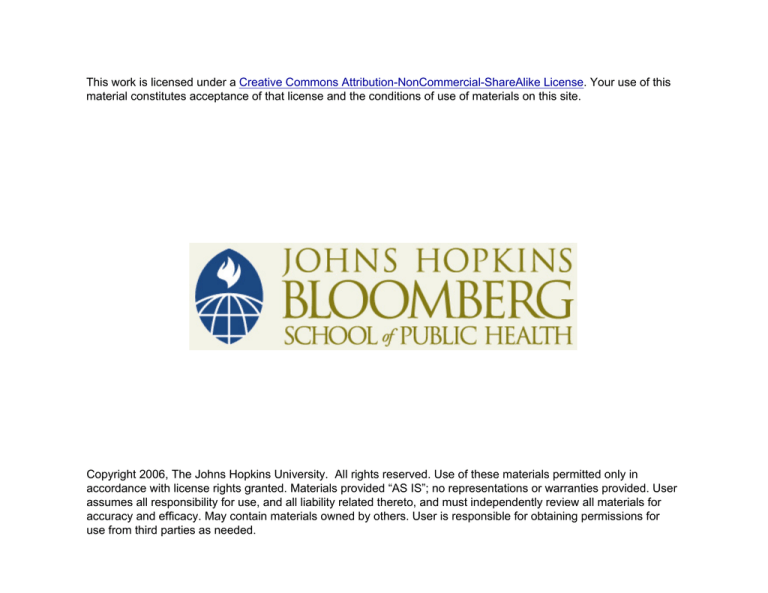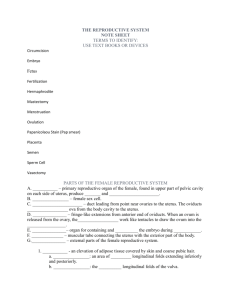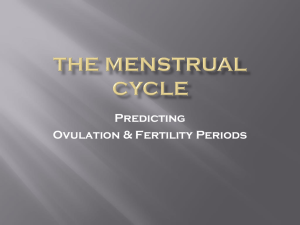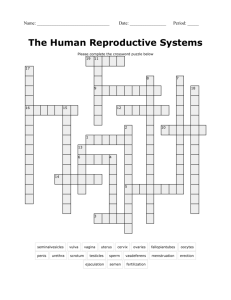
This work is licensed under a Creative Commons Attribution-NonCommercial-ShareAlike License. Your use of this
material constitutes acceptance of that license and the conditions of use of materials on this site.
Copyright 2006, The Johns Hopkins University. All rights reserved. Use of these materials permitted only in
accordance with license rights granted. Materials provided “AS IS”; no representations or warranties provided. User
assumes all responsibility for use, and all liability related thereto, and must independently review all materials for
accuracy and efficacy. May contain materials owned by others. User is responsible for obtaining permissions for
use from third parties as needed.
Anatomy and
Physiology of Human
Reproduction
Module 10a
Learning Objectives
Upon completion of this module, the
student will be able to
Describe anatomy of male and female
reproductive organs
Describe and interpret the hormonal
events underlying male and female
reproductive life cycle
Male Reproductive Tract:
Anatomy
Public Domain
Male Reproductive Anatomy
Testis
– Seminiferous tubules have germ cells
which differentiate in successive stages
(spermatogenesis) producing sperm
– Leydig cells produce testosterone required
for spermatogenesis
Continued
Male Reproductive Anatomy
Epididymis
– Transports sperm from testis to vas deferens
– Plays important role in maturation of sperm
Vas Deferens
–
Carry sperm from epididymis to urethra
– Site for male sterilization
Continued
The Hormonal Basis of Male
Reproduction : Extra-testicular
Luteinizing Hormone (LH) and Follicle
Stimulating Hormone (FSH):
– Secreted by anterior pituitary gland
(located in brain)
– Stimulates Leydig cells in the testis to
secrete testosterone
The Hormonal Basis of Male
Reproduction: Testicular
Testosterone
– Released by Leydig cells in a
pulsatile manner in response
to LH
– Has reproductive and nonreproductive sites of action.
– Required for spermatogenesis
Production of Sperm
Starts at puberty and continues all through the
life span of man- ? Menopause in men!
Hundreds of millions of spermatozoa are
produced daily – two months to leave body
Requires Testosterone and lower temperature
than normal body temperature
Has a life of 48-72 hours in the female genital
tract
Testosterone: As a Possible
Male Contraception
Testosterone as a male contraceptive– Administered testosterone suppresses the LH
production by negative feed back
– Suppression of LH results in suppression of
production of endogenous testosterone
– If dose of administered testosterone is
enough to sustain the other testosterone
dependant function, but low enough to
stimulate spermatogenesis- contraception is
achieved
– Still under exploratory stage
Female Reproductive Tract :
Anatomy
Fallopian Tubes
Ovaries
Uterus
Cervix
Public Domain
Female Reproductive Tract:
Ovaries
Equivalent of testis in males
At three months gestation contain all
potential gametes required to produce ovum
throughout the reproductive life span of the
women
Secretes female reproductive hormones
estrogen and Progesterone
Continued
Oviducts (Fallopian Tubes)
Equivalent of vas deferens in males
Transports ovum from the ovary to uterus
Site of fertilization between ovum and sperm
Site for female sterilization
Continued
Female Reproductive Tract
Uterus
– Site of implantation of fertilized
ovum if pregnancy occurs
– Site of placement of various intrauterine devices for prevention of
pregnancy
Cervix the lower most part of uterus
– Biological valve – mucus can be
monitored
– Hormonal contraceptives thickens
the mucus secretions from cervix to
block sperms entering the uterus
The Hormonal Basis of Female
Reproduction
Menstrual cycle
– Monthly cyclical changes in ovulating
women
– Repeated with a mean of 28± 7 days
– Begins with the first day of vaginal
bleeding and ends on the day prior to
the first day of vaginal bleeding of the
next cycle
Continued
Menstrual Cycle
Release of ovum from the ovary (ovulation)
divides the cycle into 2 phases:
– Follicular phase : Phase before ovulation
– Luteal phase: Phase after ovulation
Regulated by ovarian and anterior pituitary
hormones
Continued
Follicular Phase
Maturation of Graffian follicle
containing ovum
Early follicular phase: Rising FSH and
LH levels and low estrogen and
progesterone levels
Late follicular phase: Rising estrogen
levels slowly initially, then rapidly
14 ± 2 days ,variable.
Continued
Ovulation
Occurs about the middle of the cycle in a
28 days cycle , may be late if follicular
phase is longer
Follows a mid-cycle surge of estrogen,
LH and FSH levels
Hormonal contraceptives inhibit ovulation
by interfering with this mid-cycle surge in
estrogen and LH
Continued
Luteal Phase
Secretion of progesterone (from corpus
luteum)which prepares endometrium
(uterus) for pregnancy if it occurs
14 ± 2 days, much less variable
No pregnancy: The levels of estrogens
and progesterone fall¿onset of
bleeding
Pregnancy: Implantation of fertilized
zygote in the uterus ¿ no bleeding
Continued
Safe Period and Fertile Period
Safe Period
First day of
cycle
Fertile Period
(7-10 days)
Ovulation: 14th
day of cycle
Safe Period
Last day of
cycle
Continued
Safe period and Fertile Period
Woman is at risk of pregnancy for about
1/3 of days during menstrual cycle
Scientific basis: Ovulation occurs about 14
days (+ 3 days) prior to the start of the
next menstrual cycle. The life of ovum is 1
day and of sperm 3 days.
Safe period: cannot get pregnant
Continued
Fertile Period
Length: 7 to 10 days in a 28 day cycle.
Timing: May change according to the
length of the menstrual cycle
Calendar Rhythm
Mucus Observation
Basal Temperature Rise
Summary Slide
This concludes this lecture. The key
concepts introduced in this lecture include
- Anatomy and physiology of male and
female genital tract
- The hormonal basis for reproduction in
men and women
- Menstrual cycle and ovulation in women
Contraception
Module 10b
Learning Objectives
Upon completion of this module, the
student will be able to
Describe the mechanism of action,
advantages and disadvantages of
different contraceptive methods
Methods of Contraception
Traditional methods: Withdrawal, Calendar
rhythm
Modern methods:
– Permanent methods: Female
sterilization (tubectomy), male
sterilization (vasectomy)
– Non-permanent methods : Condom,
mucus, oral pills, IUD, injectables etc.
Methods of contraception
Non-permanent Methods
Non- intercourse
Intercourse related
related:
– Barriers: physical
– Hormonal: OC,
(condom/diaphragm)
injectables,
or chemical
implants
(spermicides)
– Intrauterine
– Natural
devices: Medicated Post-coital methods
or non-medicated
Modern Methods of
Contraception
Something for Everyone
Injection
Norplant
Pills
Prevent AIDS and
STDs
Male Condom
Female Condom
IUD
Breastfeeding
Abstinence
Emergency
Contraceptive
Pills
Diaphragm
and Cap
Natural
Family
Planning
Permanent Methods
Vasectomy
Tubal Ligation
Combined Oral
Contraceptives
Contain low doses of two hormones:
estrogen and progesterone
How do they work?
– Inhibit ovulation
– Thicken cervical mucus
How effective?
– Typical use (as commonly use)6-8 % pregnancy rate
– Perfect use - 0.1% pregnancy
rate
Combined Oral Contraceptives
Advantages
– Safe, effective and reversible
– Can be used at any age (adolescence to
menopause)
Potential health benefits
– Prevent/reduce iron deficiency anemia
– Reduce risk of Pelvic Inflammatory
disease
– Reduced risk of uterine /ovarian cancer
Combined Oral contraceptives (cont.)
Disadvantages:
– Have to be taken daily
– Reduce milk supply- not
recommended postpartum
Health risks
– Increased risk of Myocardial
infarction, stroke, venous
thrombosis
– Equivocal evidence of increased risk
of breast and cervical cancer
Barrier Methods
Female Condom
Male Condom
Ceridwen via Wikimedia Commons.
Some rights reserved
Flegmus via Wikimedia Commons.
GNU Free Documentation License
Condoms
Create physical barrier that block sperm
entry into vagina
Effectiveness: 6-18% failure rate on
typical use, 2-3% on perfect use
Advantages: safe and reversible,
protection against STDs including AIDS,
protection against cervical cancer
Disadvantages: High failure rates
Female Condoms
Introduced in 1992
A female controlled
method
Limited availability
Expensive
Ceridwen via Wikimedia Commons.
Some rights reserved
Intra- Uterine devices
(IUD)
Can be Non-medicated (Lippes Loop) or
medicated (copper IUDs)
How do they work?
– Interferes with the transport of
ovum to uterus
– Interferes with implantation
How effective?
– 1-6% failure rate varying with the
type of IUD
Intra-uterine Devices(IUD)
Advantages:
– Long term action (T-380- the most
common type of IUD is effective up
to 10 years, good for spacing
– Can be inserted by paramedical
workers after some training
– Reduced risk of ectopic pregnancy
Side effects and health risks:
– Increased bleeding and pain
– Increased risk of PID/ infertility,
perforation of uterus
Injectable Contraceptives
Long acting progesterones- can be
once/month or once/3 months
Inhibit ovulation and thickens cervical
mucus
Effectiveness: Failure rates less than 1%
Injectables (cont.)
Advantages: reduced risk of endometrial/ ovarian
cancer
– Reduced risk of pelvic inflammatory disease,
anemia and ectopic pregnancy
– Can be used by breast-feeding women
– Can be delivered by para-medical workers
after some training
Disadvantages: menstrual irregularity- may be a
serious side-effect in some cultures
– Equivocal evidence of increased risk of breast
and cervical cancer
Subdermal Implants (Norplant)
Long acting, low dose, progestin only
contraceptive
Delivered by means of six Silastic capsules
implanted subdermally in the arm by a
minor surgical technique
Needs to replaced every 5 years
Effectiveness- Failure rates are less than
1%
Continued
Subdermal Implants (Norplant)
Acts by inhibiting ovulation
Advantages:
– All health benefits as that of injectables
– Can be used by breast feeding women
Disadvantages: provider controlled
– Needs medical personnel to deliver and
to remove
Male and Female Sterilization
Male Sterilization (vasectomy)
– Interrupting the sperm transport
through the vas deferens
– Result: no sperm in ejaculate
Female Sterilization (tubectomy)
– Interrupts egg and sperm transport
through the fallopian tubes
– Egg and sperm cannot meet
Emergency Contraception
Also called postcoital or “morning
after”
contraception
Used after having
an unprotected sex
to prevent
pregnancy
Has to be taken within
72 hours of
unprotected sex
Within 72 hrs of unprotected
intercourse
12 hours
Repeat Dose
Continued
Emergency Contraception
The following hormonal methods can used for
emergency contraception
– 4 low dose tablets of combined oral
contraceptives followed by another dose 12
hours later
– 2 “standard dose” combined oral
contraceptives followed by another equal
dose 12 hours later
– 20-25 Progestin-only OC, and then take
another equal dose 12 hours later
Summary Slide
This concludes this lecture. The concepts
introduced in this slide are:
• Traditional methods of contraception
• Modern methods of contraception
• Mechanism of action, advantages and
disadvantages of different methods of
contraception






